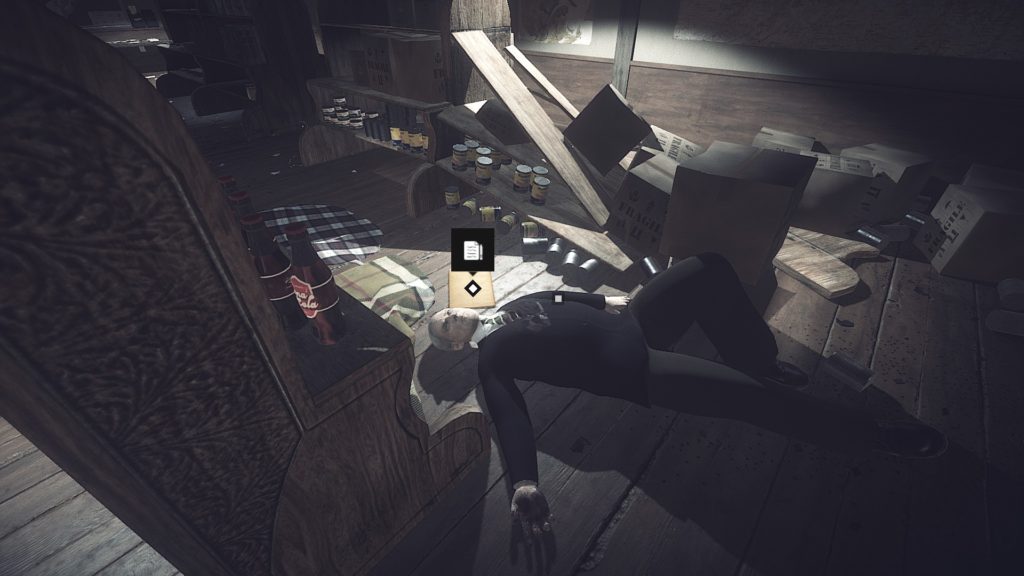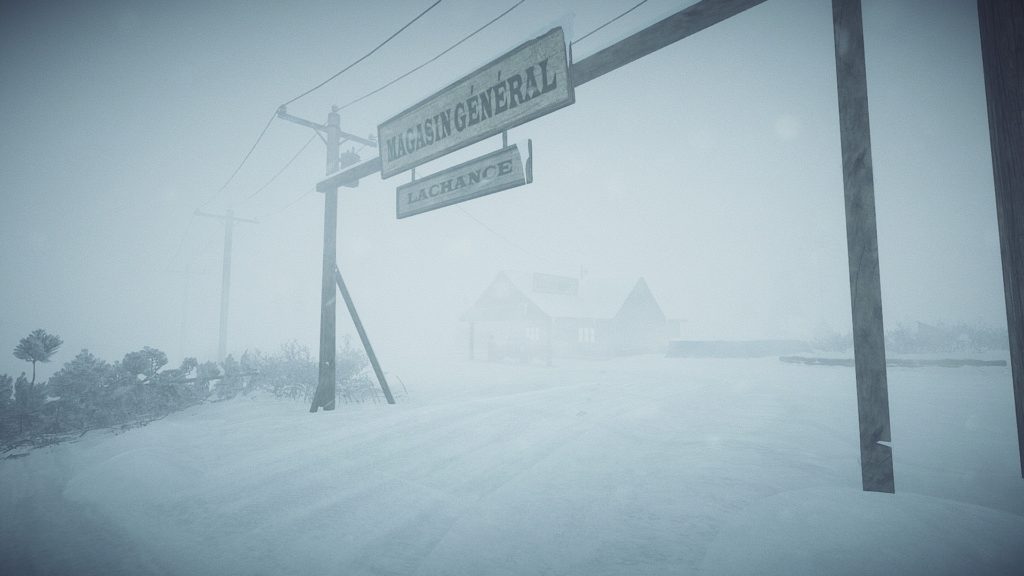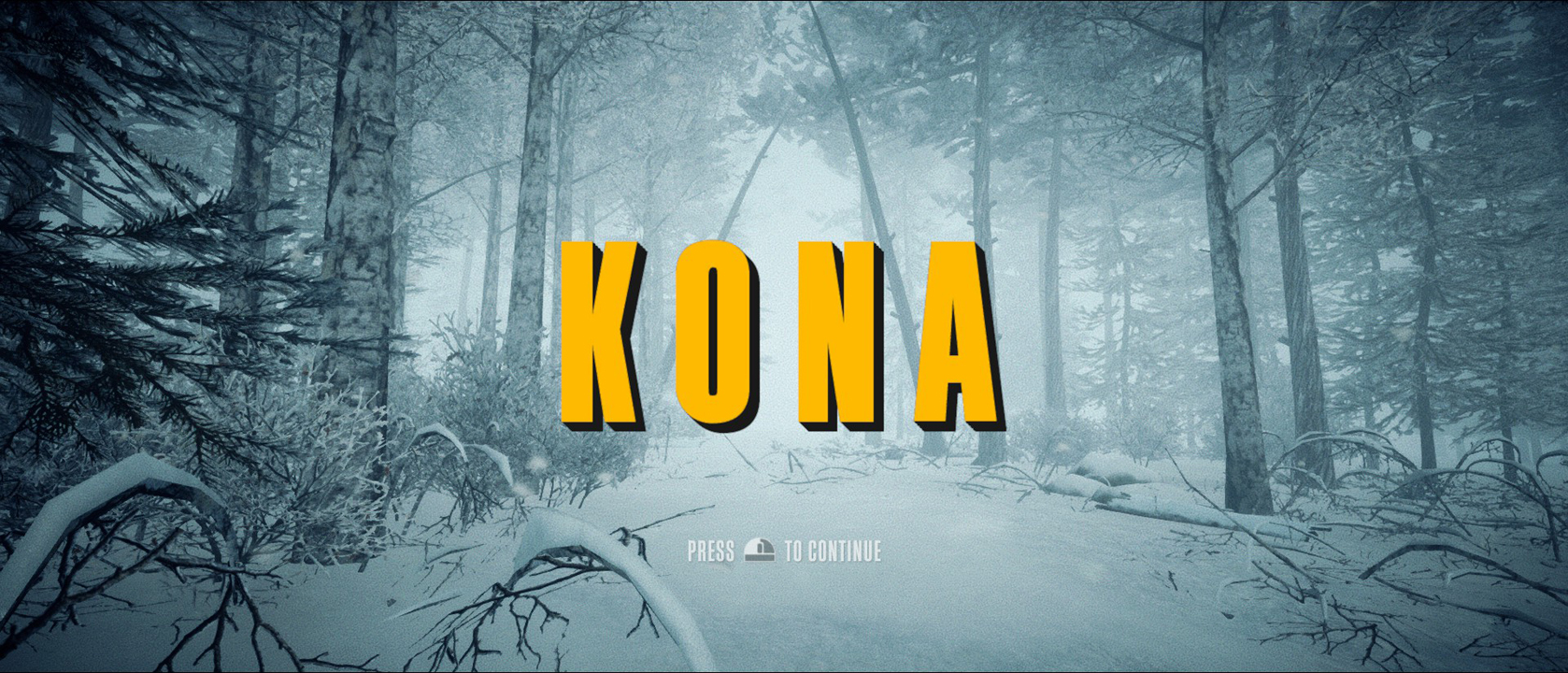I was gifted Kona by a friend and was pleased to find that it also had DLC to play the game in VR. After picking that up; I settled in for a few hours of a Canadian mystery. (minimal spoilers ahead)
Story
In Kona, you play private detective Carl Faubert. Carl has been called to a small town in the Canadian wilderness by a Mr. Hamilton to investigate some minor cases of sabotage. That particular investigation turns into just a minor point when you actually meet Hamilton.

Despite the minor problem of not getting paid, Carl decides to investigate the murder. The game opens up from there.
Gameplay
The bulk of the game is non-linear. Once you point-and-click around the gas station to fill up your truck (or even before), you can go almost anywhere on the map. The only things you need to worry about are the wolves and the cold.
Carl has three ‘health’ stats. Warmth, Health, and Calm. The Warmth stat decreases over time while you are outside or in particularly cold areas. The Health stat is consistent as long as you don’t take damage (mainly from wolves). The Calm stat fluctuates over the course of the game but is the only stat that cannot cause a “Game Over”.
Warmth is the main survival mechanic. The town of Manastan is a cold place; so you’ll need to rummage for matches, fire starters, and firewood to light campfires and wood-stoves. Once lit, these warm sanctuaries turn into autosave points, which makes for a neat dynamic where you have to decide which places would make the most of the resources in your limited inventory.

The open-world of Kona is a double-edged sword. On one hand, the non-directed nature of the game means that it really feels like a self-directed investigation. You could choose to head North towards Hamilton’s house. Or you could head around the lake to the West and discover what the town mechanic has been building in his garage. This all but guarantees that no player will experience the game in exactly the same way.
On the other hand, this also means that the story has to be past tense and diffuse. Most of the game is spent collecting various notes, letters, and diaries which piece together what happened. The core experience of Kona’s open-world investigating means that the investigation you are playing is not a significant part of the story. Instead, all of the story beats are outlined in Carl’s journal.

Indeed, Carl’s journal updates with no input from the player whenever you reach a particular location or find a useful letter. This removes any need to think about what you find; you can simply check the journal to see what everything means. When I discovered this, I stopped giving letters more than a cursory glance because I knew that that the game was piecing the puzzle together automatically.
The third-person narrator further reinforces this. Everything the narrator says talks about things that Carl did or felt, ignoring anything the player might have thought or done. I personally would have prefered if Carl was his own narrator. That would change the passive “Carl did X, and felt relieved.” to the active “I sure am glad that X worked.” Or alternatively, remove the narrator altogether. Especially with an all-knowing journal, you don’t generally need to tell the player what they did or felt.
Visuals

Visually, Kona is really nice. A snowstorm hits pretty early in the game that limits your view distance from about 50 ft. during the day to practically nothing during the night. This really fosters a feeling of isolation and mystery; especially in VR.
The few people you come across (both dead and otherwise) are on the cartoony side of realism but not uncanny. The not-dead characters are just a little stiff. A few more dynamic idle animations and better head/eye tracking would help them feel more… well… alive.
Text is clean and readable in general. Most of the notes you find are written in French but there is an English translated overlay so you don’t miss anything. The exception is the journal, which is in English by default but with a handwritten font. A menu option for clean sans-serif in the journal would make the small text much easier to read for people with reading disabilities or people playing in VR.
The car mirrors don’t work but that’s just a limitation of technology. Real-time raytracing can’t come soon enough.
Annoyances and DPD
There are very few instances of developer-player-dissonance (or DPD, post about this coming soon) in Kona because there are very few actual puzzles. And what puzzles it does have are signposted inventory puzzles. Hard to mess those up.
However, I did encounter a couple DPD annoyances.
The big one is the method of investigation. Kona requires the player to waltz into every house on the map and steal all of the useful stuff. Now, the “pick up everything that isn’t nailed down” form of adventure gaming is nothing new. But Kona sets itself up to be on the more realistic side with potential consequences. I found this feeling augmented by playing in VR where I certainly wouldn’t barge into a place without knocking.
One occupant even shoots a gun at you when you enter his house! Sure, he calms down and even offers a useful trade if you make him some moonshine. But I really don’t want to be poking around with a rifle pointed at me. Much less take stuff that isn’t offered (which, spoilers, is useful stuff).
The other minor moments of DPD come from trying to reach a high place (accentuated by playing in VR) and requiring a crowbar for an action when a hammer would have worked just as well. Nothing too serious but enough to require some frustrating backtracking and faffing about. ADVENTURE GAMES.
VR
The VR version of Kona is visually nice and performant but is awkward and annoying to play.
Driving is a bit strange with the Vive controllers but works. Tapping holding left and right of the circle-pads steers left and right while the left/right triggers brake and accelerate respectively. I didn’t experience any motion sickness from this implementation but it was unresponsive at times.
You can drive with the map open but it would have been really nice if the map was always clickable in the car, instead of having to open the inventory to get it every time. (Non-VR players can bring it out with a keyboard shortcut).
The VR version is still a point-and-click adventure game, with the right controller acting as a laser-pointer to highlight objects and trigger to select. I would have prefered grabbing interactions in most cases here. You already can’t interact with objects out of arm’s reach and this could put the interaction description on the item (where you are looking) instead of on your wrist. At minimum, I think the action description should have been on the hotspots as you select them.
Speaking of hotspots: A big problem with the VR version of Kona is when hotspots are inconsistent; either not showing up or interfering with each other. I would regularly waggle my pointer furiously over a workbench to see if something useful was on top and get the drawer hotspots to respond instead. The hotspots also seem to be distance based, which makes it harder to see what you can actually interact with when you enter a room.
The game uses the left/right trackpad on the Vive controllers (for driving and snap-turning) so it should have been easy to use “trackpad down” as a “show hotspot” button. It’s nice that the hotspots aren’t always visible so you can take in the scene. But when you can’t pick up everything; games should really tell you what you can.
The VR inventory is functional but is just a direct copy of the non-VR inventory in a black void. It would have been better if the inventory was overlaid on the world, thus keeping the player in the world when rummaging for the map. Even better would be if the inventory UI popped up on your left wrist and you could always interact with it like adjusting a watch or a Pipboy.
And lastly, the journal is spawned relative to the player’s play space instead of the player. When I went to check what I knew in the journal, there was a good chance that it was spawned behind me. A minor annoyance that got old fast.
Conclusion
As an adventure game, I would say that Kona is merely “meh”. It’s missing the puzzles and the required thinking to really feel engaging. The narration and the journal remove the player from the experience and prevents any “Aha!” moments.
But in writing this review; I realized that Kona is not a traditional adventure game. It is instead a Walking Simulator. And as a walking simulator, it’s decent. The game tells the interconnected stories of the citizens of Manastan and paints the lead-up and aftermath of a mysterious tragedy. And the climax ties up all the loose ends in a satisfactory manner. An enjoyable experience.
Just maybe don’t play it in VR.

What I played: One playthrough in VR (HTC Vive), A second playthrough to get all of the Steam achievements.
Kona is available on Steam and GOG, as well as digitally for PS4 and XB1.


